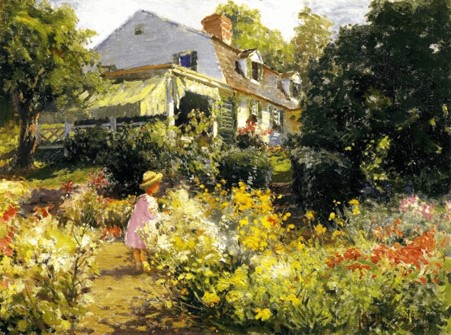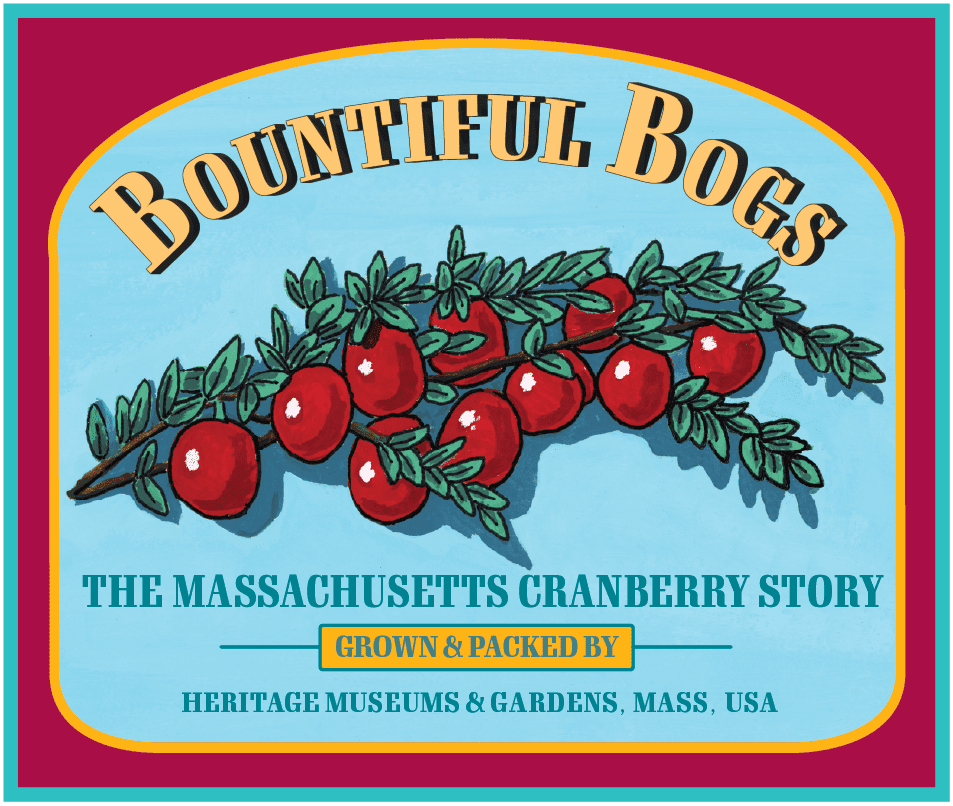Women Artists of Impressionist New England
By Amanda Wastrom, Curator
Some of the most rewarding discoveries I had while researching the Impressionist New England exhibition were all the new artist friends I met. Despite the fact that most of them are now deceased, the research process often feels like you’re making an acquaintance and developing a relationship with your subject.
In particular, I learned about many female artists working in our area throughout the late 19th and 20th century. These women were–by and large–quite successful in their time but have since fallen out of popularity. Let’s face it, when you study Impressionism in art history classes, the only female artist names that rise to the surface are Mary Cassatt and Berthe Morisot (neither of whom had strong artistic ties to New England). It was such a pleasure to be introduced to a whole new world of women artists and their works. One of my goals for the exhibition became introducing these artists to Heritage visitors too. Below, I’ve selected a few of my favorite women artists featured in the exhibition.
Jane Peterson (1876-1965)
When I think of women artists who were working in the late 1800s and early 1900s, the word that keeps coming to mind is “determination.” How much hard work, effort, and deliberate decisions must it have taken these women to go against society’s expectations and perhaps even their own families? Jane Peterson grew up in Elgin, Illinois, in an average, working-class family. She showed early talent and even traveled forty miles to Chicago to take an art aptitude test administered by the newly formed Pratt Institute of Brooklyn, NY. Let’s just say she aced the test and decided to go to Pratt in New York City. Despite her father’s misgivings and disapproval, her mother gave her $300 to cover railroad fare, tuition and first living expenses. Her mother gave her this advice when she left: “Never go out with men who smoke cigarettes. Never let a man buy or serve you wines of harsh spirits.”
Her artistic success began first as a student at Pratt and then at the Art Students League of New York. She taught and made money as an art instructor at the college level when necessary. She attracted patrons who funded extensive travels in Europe including England, Holland, Northern Italy, Venice, London, Paris, and Madrid. All the while, she was having solo shows in Paris, Boston, and Chicago. She had an active, well-traveled life which included painting trips throughout New England and, in 1916, a transcontinental painting expedition to the Canadian Northwest and Alaska aboard the private railway car of Louis Comfort Tiffany. Of her work she said, “My great and absorbing passion is the love of beauty…Beautiful things give me pleasure.”
Jane Peterson (1876-1965), Harbor at Gloucester, Massachusetts, c. 1916-1920, oil on canvas, collection of the Telfair Museum of Art, Savannah, Georgia, Museum purchase with funds provided by the Gari Melchers Collectors’ Society

Matilda Browne (1869-1947)
Being a woman in the art world is not easy, regardless of time period. In the first wave of American Impressionism in the late 1880s, women had to contend with preconceived notions that they were delicate and thus couldn’t handle the tough criticism, hard work, or (gasp!) nude models found in a typical art education. Women artists weren’t taken seriously by their male peers, by critics and collectors or by society at large. In the Old Lyme Art Colony in Connecticut, this was especially true. Male artists such as Childe Hassam and Willard Metcalf were more than happy to make money teaching female students, but they scoffed at them behind their backs. Matilda Browne was one female artist who rose above all that, earning the respect of her male peers. She was the only woman invited to paint a door panel in Florence Griswold’s boarding house–an honor reserved for esteemed members. Some of Browne’s most dazzling paintings are floral scenes such as the one shown here, in which she depicts the garden of her friend, artist Clark Vorhees.
Matilda Browne (1869–1947), In Voorhees’ Garden, 1914, oil on canvas, collection of Florence Griswold Museum, Gift of The Hartford Steam Boiler Inspection and Insurance Company

Gertrude Fiske (1878-1961)
Women artists constantly had to combat traditional societal expectations that they would get married, raise a family, run the household, and participate in society. Hobbies such as art were fine for young women to pursue but once married, they were not supposed to have a profession. If a woman did work, it was often perceived as a sign that her husband was a failure. So, for many women artists, the solution was to never get married. As artist Harriet Hosmet wrote, “An artist has no business to marry. For a man, it may be well enough, but for a woman, on whom matrimonial duties and cares weigh more heavily, it is moral wrong, I think, for she must either neglect her profession or her family.”
Born into a wealthy Boston family, Gertrude Fiske had financial means to pursue painting full-time without the burdens of marriage or child rearing. In addition to travels in Europe, she studied at the School of the Museum of Fine Arts, Boston under Edmund Tarbell and Frank Benson and with Charles Woodbury in Ogunquit. Fiske became a leader in the regional art world and was the first woman appointed to the board of the Massachusetts State Art Commission. The appointing board said, “Fiske ranks with the foremost painters in the country…and there are few artists who have been awarded more prizes than Miss Fiske in the entire country. There is a note of personal distinction in all of her work – a virile note.”
Fiske was a member of “The Pine Hill Girls” a group of four women artists, who came to Ogunquit to study with Charles Woodbury at his famed summer art school during the early decades of the 20th century. Finding fellowship and inspiration they all eventually purchased land from him on Pine Hill Road and built summer residences within walking distance of his school. They all had careers of their own as artists or art educators. Some became instructors at the Woodbury school, and all were among the founding members and directors of the Ogunquit Art Association.
It is said that after Charles Woodbury’s first wife died, he asked Fiske to marry him. She refused as she preferred her independence and knew that once she married, she’d be “Mrs. Charles Woodbury.”
Gertrude Fiske (1878-1961), Old Cove (Perkins Cove), oil on canvas, collection of Darin R. Leese Family Collection

Lilian Westcott Hale (1881-1963)
Many of the women artists who were able to overcome society’s hurdles did not do it alone. Lilian Hale came from a comfortable family with progressive ideas about education. As a result, she was able to study art first in Connecticut, where she grew up, and later in Boston at the School of the Museum of Fine Arts. Her husband, artist Philip Leslie Hale, whom she met while studying in Boston, was always supportive of her work and her career, as revealed in this excerpt from a letter he wrote before they were married, “I want what is best for you…My great and chiefest feeling is that I don’t want you, in the years to come, to look back, and in your heart of hearts regret…I want you to feel that you’ve had a first rate show and haven’t been interfered with–not to feel that ‘it might have been.’”
Thanks to this supportive relationship, Hale successfully navigated marriage, motherhood and an art career. She had her first one-woman show in Boston in 1908, the same year that her daughter was born. Her mentor, artist Edmund Tarbell, exclaimed after seeing her drawings, “Your drawings are perfectly beautiful—as fine as anything could be. They belong with our old friends Leonardo, Holbein and Ingres, and are to me the finest modern drawings I have ever seen.”

Today, about a century after these four women made these paintings, an artistic life is still not an easy choice and often demands sacrifice and a strong will. These artworks stand as triumphant examples that women artists continue to find ways to get their work out into the world. There are many more stories like these in the Impressionist New England exhibition–of women defying expectations and persevering against all kinds of life challenges.








